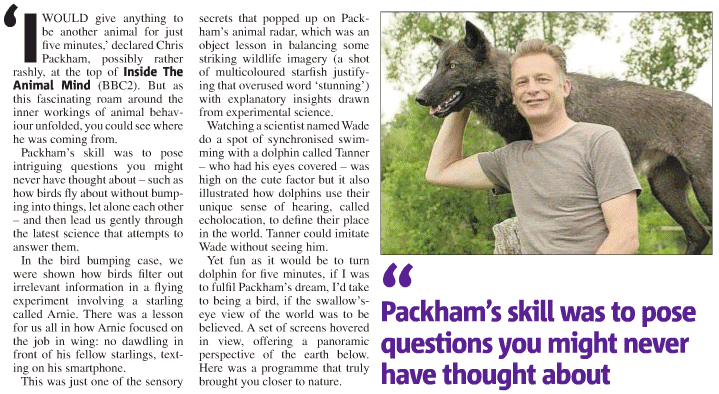Inside The Minds of Animals
Science is revealing just how smart other species can be - and raising new questions about how we treat them.
By Jeffrey Kruger
- Smart Animals To see a portfolio of creature portraits by Finlay MacKay, go to time.com/smart_animals
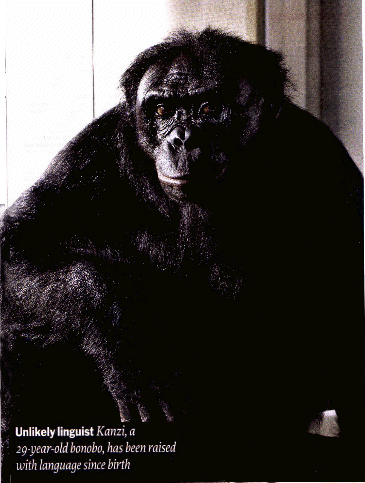
NOT LONG AGO,I spent the morning having coffee with Kanzi. It wasn t my idea; Kanzi invited me though he did so in his customary clipped way. Kanzi is a fellow of few words-384 of them by formal count though he probably knows dozens more. He has a perfectly serviceable voice-very clear, very expressive and very, very loud. But it's not especially good for forming words, which is the way of things when you're a bonobo, the close and more peaceable cousin of the chimpanzee.
But Kanzi is talkative all the same. For much of his day, he keeps a sort of glossary close at hand-three laminated, place mat-like sheets filled with hundreds of colorful symbols that represent all the words he's been taught by his minders or picked up on his own. He can build thoughts and sentences, even conjugate, all by pointing. The sheets include not just easy nouns and verbs like ball and jell-O and run and tickle but also concept words like from and later and grammatical elements like the -ing and -ed endings signifying tense.
Kanzi knows the value of breaking the ice before getting down to business.
So he points to the coffee icon on his glossary and then points to me. He
then sweeps his arm wider, taking in primatologist
Sue
Savage-Rumbaugh, an investigator at the Great Ape Trust-the research
center in Des Moines, Iowa, that Kanzi calls home- and lab supervisor Tyler
Romine. Romine fetches four coffees-hot, but not too hot- takes one to Kanzi
in his patio enclosure on the other side of a Plexiglas window and then rejoins
us. Kanzi sips-gulps, actually-and since our voices are picked up by microphones,
he listens as we
talk.
"We told him that a visitor was coming," Savage-Rumbaugh tells me. "He's been excited, but he was stubborn this morning, and we couldn't get him to come out to the yard. So we had to negotiate a piece of honeydew melon in exchange." Honeydew is not yet on Kanzi's word list; instead, he points to the glyphs for green, yellow and watermelon. When he tried kale, he named it "slow lettuce" because it takes longer to chew than regular lettuce.
The not-for-profit Great Ape Trust is home to seven bonobos, including Kanzi's baby son Teco, born this year on June 1. Kanzi is by no means the first ape to have been taught language. The famous Koko, Washoe and others came before him. But the Trust takes a novel approach, raising apes from birth with spoken and symbolic language as a constant feature of their days. Just as human mothers take babies on walks and chatter to them about what they see even though the child does yet not understand, so too do the scientists at the Trust narrate the lives of their bonobos. With the help of such total immersion, the apes are learning to communicate better, faster and with greater complexity.
All the same, today Kanzi is not interested in saying much, preferring to run and leap and display his physical prowess instead. "Ball," he taps on one of his glossary sheets when he finishes his coffee.
"Tell him you'll get it for him," Savage-Rumbaugh instructs me and then shows me where the necessary symbols are on a sheet I have in hand. "Yes-I-will-chase-the- ball-for-you," I slowly peck out, chase being a word Kanzi uses interchangeably with get.
It takes me a while to find the ball in an office down the hall, and when I finally return, Savage-Rumbaugh verbally asks Kanzi, "Are you ready to play?" He looks at us balefully. "Past ready," he pecks.
Humans have a fraught relationship with beasts. They are our companions and our chattel, our family members and our laborers, our household pets and our household pests. We love them and cage them, admire them and abuse them. And, of course, we cook and eat them.
Our dodge-a not unreasonable one- has always been that animals are ours to do with as we please simply because they don't suffer the way we do. They don't think, not in any meaningful way. They don't worry. They have no sense of the future or their own mortality. They may pair-bond, but they don't love. For all we know, they may not even be conscious. "The reason animals do not speak as we do is not that they lack the organs," René Descartes once said, "but that they have no thoughts." For many people, the Bible offers the most powerful argument of all. Human beings were granted "dominion over the beasts of the field," and there the discussion can more or less stop.
But one by one, the berms we've built between ourselves and the beasts are being washed away. Humans are the only animals that use tools, we used to say. But what about the birds and apes that we now know do as well? Humans are the only ones who are empathic and generous, then. But what about the monkeys that practice charity and the elephants that mourn their dead? Humans are the only ones who experience joy and a knowledge of the future. But what about the U.K. study just last month showing that pigs raised in comfortable environments exhibit optimism, moving expectantly toward a new sound instead of retreating warily from it? And as for humans as the only beasts with language? Kanzi himself could tell you that's not true.
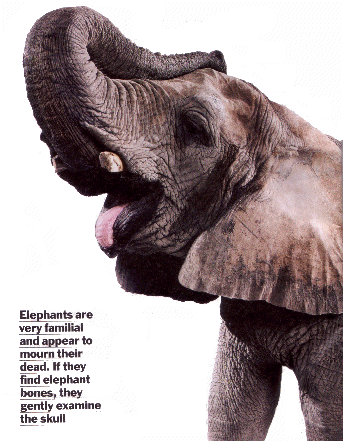 All
of that is forcing us to look at animals in a new way. With his 1975 book
Animal Liberation, bioethicist
Peter Singer
of Princeton University launched what became known as the animal-rights movement.
The ability to suffer, he argued, is a great cross-species leveler, and we
should not inflict pain on or cause fear in an animal that we wouldn't want
to experience ourselves. This idea has never met with universal agreement,
but new studies are giving it more legitimacy than ever. It's not enough
to study an animal's brain, scientists now say; we need to know its mind.
All
of that is forcing us to look at animals in a new way. With his 1975 book
Animal Liberation, bioethicist
Peter Singer
of Princeton University launched what became known as the animal-rights movement.
The ability to suffer, he argued, is a great cross-species leveler, and we
should not inflict pain on or cause fear in an animal that we wouldn't want
to experience ourselves. This idea has never met with universal agreement,
but new studies are giving it more legitimacy than ever. It's not enough
to study an animal's brain, scientists now say; we need to know its mind.
Conscious Critters
THERE ARE A LOT OF OBSTACLES IN THE WAY of our understanding animal intelligence- not the least being that we can't even agree whether nonhuman species are conscious. We accept that chimps and dolphins experience awareness; we like to think dogs and cats do. But what about mice and newts? What about a fly? Is anything going on there at all? A tiny brain in a simple animal has enough to do just controlling basic bodily functions. Why waste synapses on consciousness if the system can run on autopilot?
There's more than species chauvinism in that question. "Below a certain threshold, it's quite possible there's no subjective experience," says cognitive psychologist Dedre Gentner of Northwestern University. "I don't know that you need to ascribe anything more to the behavior of a cockroach than a set of local reflexes that make it run away from bad things and toward good things."
Where that line should be drawn is impossible to say, since our judgment is clouded by our feelings about any given species. A cockroach likely has no less brainpower than a butterfly, but we're quicker to deny it consciousness because it's a species we dislike. Still, most scientists agree that awareness is probably controlled by a sort of cognitive rheostat, with consciousness burning brightest in humans and other high animals and fading to a flicker-and finally blackness-in very low ones.
"It would be perverse to deny consciousness to mammals," says Steven Pinker, a Harvard psychologist and the author of The stuff of thought "Birds and other vertebrates are almost certainly conscious too. When it gets down to Oysters and spiders, we're on shakier ground."
Among animals aware of their existence, intellect falls on a sliding scale as well, one often seen as a function of brain size. Here humans like to think they're kings. The human brain is a big one-about 1,400 g (3 lb.). But the dolphin brain weighs up to 1,700 g (3.75 lb.), and the killer whale carries a monster-size 5,600g (12.3 lb.) brain. But we're smaller than the dolphin and much smaller than the whale, so correcting for body size, we're back in first, right? Nope. The brain of the Etruscan shrew weighs just 0.1 g (0.0035 oz.), yet relative to its tiny body, its brain is bigger than ours.
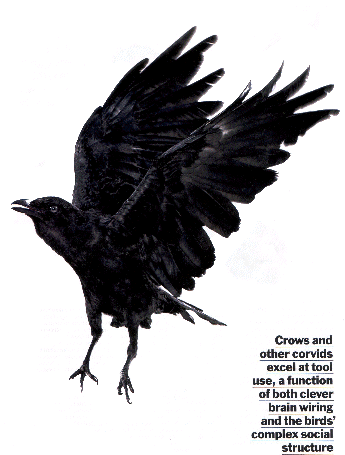 While
the size of the brain certainly has some relation to smarts, much more can
be learned from its structure. Higher thinking takes place in the cerebral
cortex, the most evolved region of the
brain and one many animals lack.
Mammals are members of the cerebral-cortex club, and as a rule, the bigger
and more complex that brain region is, the more
intelligent the
animal. But it's not the only route to creative thinking. Consider tool use.
Humans are magicians with tools, apes dabble in them, and otters have mastered
the task of smashing mollusks with rocks to get the meat inside-which, though
primitive, counts. But if creativity lives in the cerebral cortex, why are
corvids, the class of birds that includes
crows and
jays, better tool users than nearly all non- human species?
While
the size of the brain certainly has some relation to smarts, much more can
be learned from its structure. Higher thinking takes place in the cerebral
cortex, the most evolved region of the
brain and one many animals lack.
Mammals are members of the cerebral-cortex club, and as a rule, the bigger
and more complex that brain region is, the more
intelligent the
animal. But it's not the only route to creative thinking. Consider tool use.
Humans are magicians with tools, apes dabble in them, and otters have mastered
the task of smashing mollusks with rocks to get the meat inside-which, though
primitive, counts. But if creativity lives in the cerebral cortex, why are
corvids, the class of birds that includes
crows and
jays, better tool users than nearly all non- human species?
Crows, for example, have proved themselves adept at bending wire to create a hook so they can fish a basket of food from the bottom of a plastic tube. More remarkably, last year a zoologist at the University of Cambridge-the aptly named Christopher Bird-found that the rook, a member of the crow family, could reason through how to drop stones into a pitcher partly filled with water in order to raise the level high enough to drink from it. What's more, the rooks selected the largest stones first, apparently realizing they would raise the level faster. Aesop wrote a tale about a bird that managed just such a task more than 2,500 years ago, but it took 21st century scientists to show that the feat is no fable.
How the birds performed such a stunt without a cerebral cortex probably has something to do with a brain region they do share with mammals: the basal ganglia, more primitive structures involved in learning. Mammalian basal ganglia are made up of a number of structures, while those in birds are streamlined down to one. Earlier this year, a collaborative team at MIT and Hebrew University of Jerusalem found that while the specialized cells in each section of mammalian basal ganglia do equally specialized work, the undifferentiated ones in birds' brains multitask, doing all those jobs at once. The result is the same-information is processed-but birds do it more efficiently.
In the case of corvids and other animals, what may drive intelligence higher still is the structure not of their brains but of their societies. It's easier to bea solitary animal than a social one. When you hunt and eat alone, like the polar bear, you don't have to negotiate power struggles or collaborate in stalking prey. But it's in that behavior-particularly the hunt-that animals behave most cleverly'.
Consider the king of the beasts. "Lions do very cool things," says animal biologist Christine Drea of Duke University. "One animal positions itself for the ambush, and another pushes the prey in that direction." More impressive still is the unglamorous hyena. 'A hyena by itself can take out a wildebeest, but it takes several to bring down a zebra," she says. "So they plan the size of their party in advance and then go out hunting particular prey. In effect, they say, Let's go get some zebras. They'll even bypass a wildebeest if they see one on the way."
Last year, Drea conducted a study of hyena cooperation, releasing pairs of them into a pen in which a pair of ropes dangled from an overhead platform. If the animals pulled the ropes in unison-and only in unison- the platform would spill out food. "The first pair walked into the pen and figured it out in less than two minutes," Drea says. "My jaw literally dropped."
For these kinds of animals, it's not clear what the cause-and-effect relationship is-whether living cooperatively boosts intelligence or if innate intelligence makes it easier to live cooperatively. It's certainly significant that corvids are the most social of birds, with long lives and stable group bonds, and that they're the ones that have proved so handy. It's also significant that herd animals, like cows and buffalo, exhibit little intelligence. Though they live collectively, there's little shape to their society. "In a buffalo herd, Bob doesn't care who Betty is," Drea says. "But among primates, social carnivores, whales and dolphins, every individual has a particular place."
Self and Other
IT'S EASY ENOUGH TO STUDY THE BRAIN AND behavior of an animal, but subtler cognitive abilities are harder to map. One of the most important skills human children must learn is something called the theory of mind: the idea that not all knowledge is universal knowledge. A toddler who watches a babysitter hide a toy in a room will assume that anyone who walks in afterward knows where the toy is too. It's not until about age 3 that kids realize that just because they know something, it doesn't mean somebody else knows it also.
The theory of mind is central to communication and self-awareness, and it's the rare animal that exhibits it, though some do. Dogs understand innately what pointing means: that someone has information to share and that your attention is being drawn to it so that you can learn too. That seems simple, but only because we're born with the ability and, by the way, have fingers with which to do the pointing.
Great apes, despite their impressive intellect and five-fingered hands, do not seem to come factory-loaded for pointing. But they may just lack the opportunity to practice it. A baby ape rarely lets go of its mother, clinging to her abdomen as she knuckle- walks from place to place. But Kanzi, who was raised in captivity, was often carried in human arms, and that left his hands free for communication.
"By the time Kanzi was 9 months old, he was already pointing at things," says Savage-Rumbaugh. I witnessed him do it in Iowa, not only when he pointed at me to invite me for coffee but also when he swept his hand toward the hallway in a be-quick- about-it gesture as I went to get him his ball.
Pointing isn't the only indicator of a smart species that grasps the theory of mind. Blue jays-another corvid-cache food for later retrieval and are very mindful of whether other animals are around to witness where they've hidden a stash. If the jays have indeed been watched, they'll wait until the other animal leaves and then move the food. They not only understand that another creature has a mind; they also manipulate what's inside it.
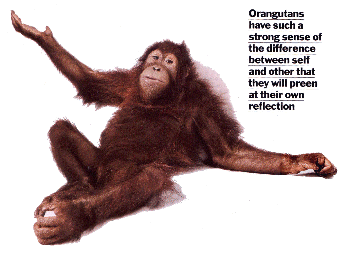 The
gold standard for demonstrating an understanding of the self-other distinction
is the mirror test: whether an animal can see its reflection and recognize
what it is. It may be adorable when a kitten sees itself in a full-length
mirror and runs around to the other side of the door looking for what it
thought was a playmate, but it's not head-of-the-class stuff. Elephants,
apes and dolphins are among the few creatures that can pass the mirror test.
All three respond appropriately when they look in a mirror after a spot of
paint is applied to their forehead or another part of their body. Apes and
elephants will reach up to touch the mark with finger or trunk rather than
reach out to touch the reflection. Dolphins will position themselves so they
can see the reflection of the mark better.
The
gold standard for demonstrating an understanding of the self-other distinction
is the mirror test: whether an animal can see its reflection and recognize
what it is. It may be adorable when a kitten sees itself in a full-length
mirror and runs around to the other side of the door looking for what it
thought was a playmate, but it's not head-of-the-class stuff. Elephants,
apes and dolphins are among the few creatures that can pass the mirror test.
All three respond appropriately when they look in a mirror after a spot of
paint is applied to their forehead or another part of their body. Apes and
elephants will reach up to touch the mark with finger or trunk rather than
reach out to touch the reflection. Dolphins will position themselves so they
can see the reflection of the mark better.
"If you put a bracelet on an orangutan and put it in front of a mirror, it doesn't just look at the bracelet," says Bhagavan Antle, director of the Institute of Greatly Endangered and Rare Species in Myrtle Beach, S.C. "It puts the bracelet up to its face and shakes it. It interacts with its reflection."
With or without mirror smarts, some animals are also adept at grasping abstractions, particularly the ideas of sameness and difference. Small children know that a picture of two apples is different from a picture of a pear and a banana; in one case, the objects match, and in the other they don't. It's harder for them to take the next step-correctly matching a picture of two apples to a picture of two bananas instead of to a picture of an orange and a plum.
"It's called relations between relations, and it's a basic scaffold of intelligence," says psychologist Ed Wasserman of the University of Iowa. Last year Wasserman conducted a study that proved some animals have begun building that scaffold. In his research, baboons and-surprisingly- pigeons got the relations-between-relations idea, correctly identifying the proper pairings with a peck or a joystick when images were flashed on a screen.
Significantly, just as humans better understand an idea when they have a term to describe it (imagine explaining, say, satisfaction if the word didn't exist), so do animals benefit from such labels. Psychologist David Premack of the University of Pennsylvania found that when chimps were taught symbols for same and different, they later performed better on analogy tests.
 Beyond
Smarts
Beyond
Smarts
IF ANIMALS CAN REASON-EVEN IF IT'S IN a way we'd consider crude-the unavoidable
question becomes, Can they feel? Do they experience empathy or compassion?
Can they love or care or hope or grieve? And what does that say about how
we treat them? For science, it would be safest simply to walk away from a
question so booby-trapped with imponderables. But science can't help itself,
and at least some investigators are exploring these ideas too.
It's well established that elephants appear to mourn their dead, lingering over a herd mate's body with what looks like sorrow. They show similar interest-even what appears to be respect-when they encounter elephant bones, gently examining them, paying special attention to the skull and tusks. Apes also remain close to a dead troop mate for days.
Empathy for living members of the same species is not unheard of either. "When rats are in pain and wriggling, other rats that are watching will wriggle in parallel," says Marc Hauser, professor of psychology and anthropological biology at Harvard. "You don't need neurobiology to tell you that suggests awareness." A 2008 study by primatologist Frans de Waal and others at the Yerkes National Primate Research Center in Atlanta showed that when capuchin monkeys were offered a choice between two tokens-one that would buy two slices of apple and one that would buy one slice each for them and a partner monkey-they chose the generous option, provided the partner was a relative or at least familiar. The Yerkes team believes that part of the capuchins' behavior was due to a simple sense of pleasure they experience in giving, an idea consistent with studies of the human brain that reveal activity in the reward centers after subjects give to charity.
Animal-liberationist Singer believes that such evidence of noble impulses among animals is a perfectly fine argument in defense of their right to live dignified lives, but it's not a necessary one. Indeed, one of his central premises is that to the extent that humans and animals can experience their worlds, they are equals. "Similar amounts of pain are equally bad," he says, "whether felt by a human or a mouse?"
Hauser takes a more nuanced view, arguing that people are possessed of what he calls humaniqueness, a suite of cognitive skills including the ability to recombine information to gain new understanding, a talent animals simply don't have. All creatures may exist on a developmental continuum, he argues, but the gap between us and the second-place finishers is so big that it shows we truly are something special. "Animals have a myopic intelligence," Hauser says. "But they never experience the aha moment that a 2 year-old child gets."
No matter what any one scientist thinks of animal cognition, nearly all agree that the way we treat domesticated animals is indefensible-though in certain parts of the world, improvements are being made. The E.U.'s official animal-welfare policies begin with the premise that animals are sentient beings and must be treated accordingly. This includes humane conditions on farms and in vehicles during transport and proper stunning before killing in slaughterhouses.
In the U.S., food animals are overwhelmingly raised on factory farms, where cattle and pigs are jammed together by the thousands and chickens are confined in cages that barely allow them to stand. But here too, public sentiment is changing. Roughly half of vegetarians list moral concerns as the chief reason for giving up meat. Still, vegetarians as a whole make up only about 3% of the U.S. population, a figure that has barely budged since before the days of Singer's manifesto. And there are three times as many ex-vegetarians as practicing ones.
Even Singer doesn't believe we're likely to wake up in a vegan world anytime soon. For that matter, he doesn't think it's morally necessary. Eating meat to avoid starvation is all right, he believes, and some creatures are fair game all the time, provided they're grown sustainably. "I think there's very little likelihood that oysters, mussels and clams have any consciousness, so it's defensible to eat them," he says.
What's more, we're not going to quit using animals in other ways that benefit humans either-testing drugs, for example. But we could surely stop using them to test cosmetics, a practice the E.U. is also moving to ban. We could surely eat less meat and treat animals better before we convert them from creature to dinner. And we could rethink zoos, marine parks and other forms of animal entertainment.
Ultimately, the same biological knob that adjusts animal consciousness up or down ought to govern how we value the way those species experience their lives. A mere ape in our world may be a scholar in its own, and what looks to us like the low life of a beast may be a source of deep satisfaction for the beast itself. Kanzi's glossary is full of words like noodles and sugar and candy and night, but scattered among them are also good and happy and he and tomorrow. If it's true that all those words have meaning to him, then the life he lives-and by extension, those of other animals-may be rich and worthy ones indeed.
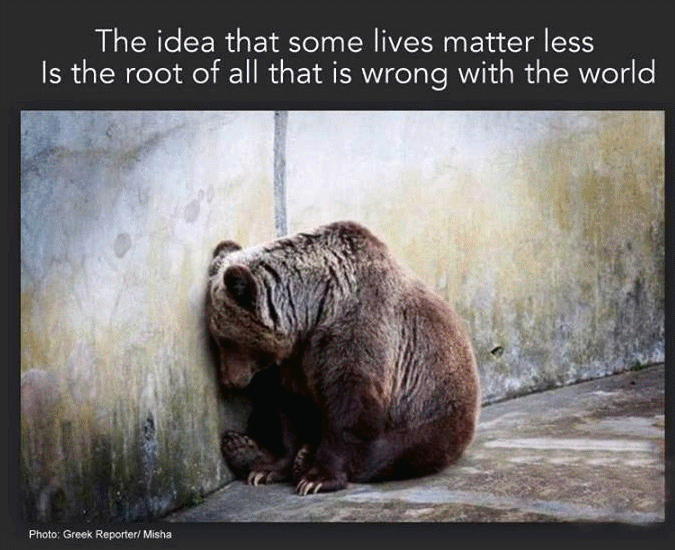
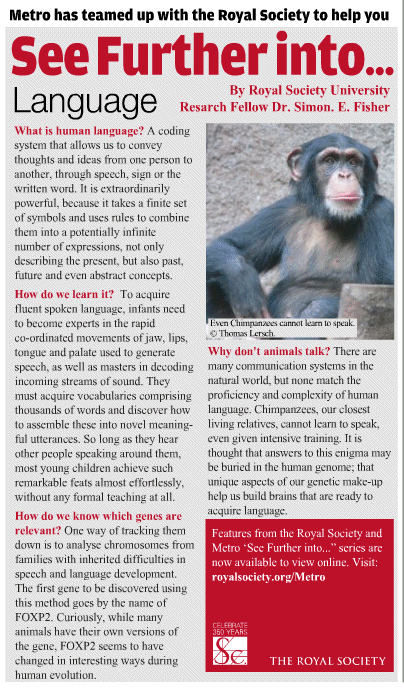
|
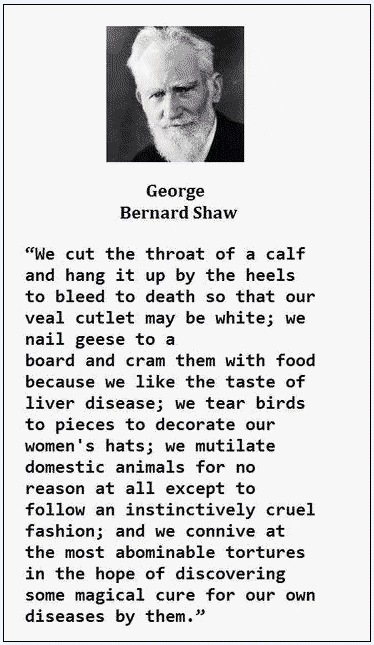
|
Bob Holmes assesses the environmental argument for giving up eating meat (17 July, p 28), tacitly accepting the broad scientific consensus that current animal-farming techniques have unsustainable environmental impacts. However, it is not just meat that is implicated in such damage, but all products we derive from farmed animals.
The Vegan Society has reviewed the evidence in its Global Food Security literature (bit.ly/aA9NfE).
Holmes suggests that radical transformation of the animal-farming industry might one day reduce the environmental damage it causes. That's all well and good, but the fact is that the world's animal-farming industry, as it is today, is one of the top three causes of all major environmental problems, from local water pollution to global climate change.
This implies that there is a strong environmental case for switching from meat to plant-based alternatives.
From Vicki Hird, Real Food Team, Friends of the Earth
